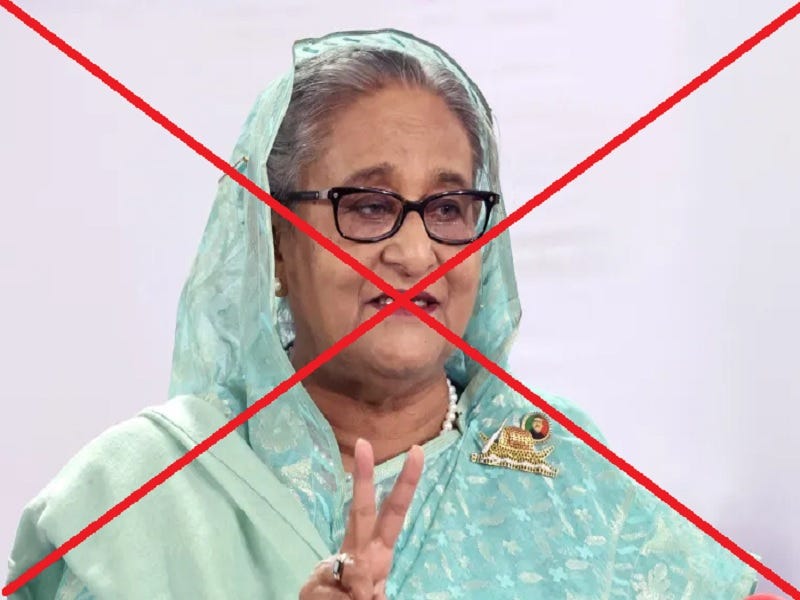U.S. Sponsored Regime Change and “Color Revolution” in Bangladesh
What just happened in Bangladesh is ominously similar to 2014’s “EuroMaidan” in
Ukraine where legitimate grievances gave rise to a nationwide protest movement that was then co-opted by political opportunists, radicals, and external forces to carry out regime change like the West wanted.
Bangladeshi Prime Minister Sheikh Hasina just resigned and fled the country on Monday as rioters stormed her palace, which prompted military chief Waker-uz-Zaman to declare a transitional government and an investigation into the deaths that took place throughout this summer’s unrest. He also said that martial law won’t be imposed if the country returns to peace, though that remains to be seen. Here are some background briefings about this fast-moving sequence of events:
- 16 April 2023: “Why’s The US Scheming To Carry Out Regime Change In Bangladesh?”
- 26 November 2023: “Russia Warned That The US Might Orchestrate A Color Revolution In Bangladesh”
- 10 January 2024: “The Outcome Of The Bangladeshi & Bhutanese Elections Gives India Strategic Breathing Space”
- 28 January 2024: “The Bangladeshi Opposition’s New Narrative Is Meant To Maximally Appeal To The West”
- 27 May 2024: “Bangladesh Warned About A Western Plot To Carve Out A Christian Proxy State In The Region
- 25 July 2024: “The Unrest In Bangladesh Isn’t A Color Revolution But It Could Still Easily Become One”
- 5 August 2024: “Bangladesh Has Descended Into The Throes Of A Full-Blown Color Revolution”
The last-mentioned piece took for granted that the military would resort to all means necessary for maintaining law and order, but that ultimately wasn’t the case after they refused to use lethal force to stop a large number of rioters from storming the presidential palace. It’s unclear whether humanitarian/moral considerations or fears of Western sanctions were responsible, but in any case, that flaw was responsible for incorrectly predicting that the regime change wouldn’t succeed.

What just happened in Bangladesh is ominously similar to 2014’s “EuroMaidan” in Ukraine where legitimate grievances gave rise to a nationwide protest movement that was then co-opted by political opportunists, radicals, and external forces to carry out regime change like the West wanted. Unlike Ukraine, however, the military is leading the political transition and might thus help to stabilize the country instead of allowing it to turn into a black hole of regional chaos (whether right away or later).
Even so, another comparison is relevant to mention, and it’s that the victorious side in Bangladesh blames India for propping up what they portray as their now-ousted “dictator” just like the victorious one in Ukraine said the same about Russia’s prior support of Viktor Yanukovich. No matter what the military’s envisaged foreign policy might be during the interim, it’ll likely capitulate to public pressure to at the very least somewhat distance itself from India for the sake of restoring stability in the streets.
Accordingly, the promised investigation might also conveniently implicate Hasina and those close to her for this summer’s deaths in order to cover up for the victorious side’s role in all of this, just like Ukraine’s post-“Maidan” investigation blamed Yanukovich and his ilk (though more of the truth came out later on). Depending on how everything unfolds and the pace thereof, Bangladesh might return to its previous role as a thorn in India’s side, which could take the form of hosting groups that Delhi designated as terrorists.
Northeast India was afflicted by a brief but very intense round of unrest last summer in Manipur, which readers can learn more about here and here, and this reminded policymakers of how vulnerable that diverse part of their country is to instability caused by an influx of different demographic groups. Christian Kukis from Myanmar clashed with indigenous Hindu Meiteis in Manipur, while Muslim Bangladeshis have previously clashed with indigenous groups in bordering Northeast Indian States.
The second-mentioned fault line is exceptionally dangerous due to Bangladesh being an independent state, unlike the so-called “Kukiland” that separatist groups want to carve out of the region with Western support. Accordingly, any perceived violation of its people’s rights – including illegal immigrants’ – could worsen bilateral tensions, thus risking fears of a regional war. To be clear, this is only the worst-case scenario, and folks shouldn’t fearmonger about it at this point.
Nevertheless, any movement in that direction could lead to a major security crisis for India that could be exploited by the US and China in different ways, the first through support for the armed forces and potentially affiliated non-state groups active in India and the latter through a prospective base. After all, if Bangladesh comes to fear India or at least artificially manufactures such a perception, then it naturally follows that it might try to “balance” India by comprehensively expanding military ties with China.
The best way forward would be for the situation at home to stabilize and for Bangladesh to retain its prior government’s Indian-friendly policies, though that’s unlikely to materialize for the reasons that were explained. The second-best possibility is that ties with India cool, but no mutual mistrust follows at the state-to-state levels. And finally, the worst-case scenario is that relations deteriorate, after which the US and China exploit this in their own way to pile pressure upon India (whether coordinated or not).
*
Click the share button below to email/forward this article to your friends and colleagues. Follow us on Instagram and Twitter and subscribe to our Telegram Channel. Feel free to repost and share widely Global Research articles.
Spread the Truth, Refer a Friend to Global Research
This article was originally published on the author’s Substack, Andrew Korybko’s Newsletter.
Andrew Korybko is an American Moscow-based political analyst specializing in the relationship between the US strategy in Afro-Eurasia, China’s One Belt One Road global vision of New Silk Road connectivity, and Hybrid Warfare. He is a regular contributor to Global Research.
Featured image is from the author

No comments:
Post a Comment